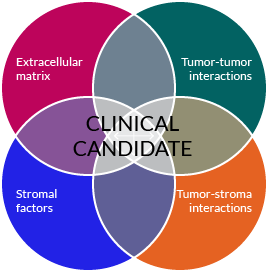Greater than ninety percent of new drugs do not reach the market because they fail during clinical development
Reconstructed Organ Platform
Reconstructed organ technology is a preclinical platform designed to evaluate investigational therapeutics, drug candidates, and drug combinations within the native microenvironment of human tissues under the conditions of environment-mediated drug resistance (EM-DR) responsible for failure of multiple treatment regimens in patients. Therapeutic agents that retain potency under EM-DR established by the elements of tumor microenvironment recapitulated within each reconstructed organ, demonstrate high correlation with clinical response. Our pharmaceutical partners are using the reconstructed organ technology to eliminate ineffective compounds and identify drugs and drug combinations that will actually work in patients.

A successful drug candidate has to overcome drug-resistance induced by the multiple factors in tumor microenvironment.




